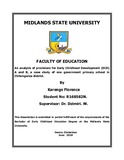Please use this identifier to cite or link to this item:
https://cris.library.msu.ac.zw//handle/11408/3105Full metadata record
| DC Field | Value | Language |
|---|---|---|
| dc.contributor.author | Karengo, Florence | - |
| dc.date.accessioned | 2018-08-29T10:45:56Z | - |
| dc.date.available | 2018-08-29T10:45:56Z | - |
| dc.date.issued | 2018 | - |
| dc.identifier.uri | http://hdl.handle.net/11408/3105 | - |
| dc.description.abstract | The research contains an analysis of provisions for ECD A and B, a case study of one government primary school in Chitungwiza district. A sporadic rush of attachment of childcare facilities has been witnessed in Zimbabwe soon after the circulation of Director’s Circular 12 of 2005 in which government schools were given the mandate to attach ECD A and B facilities in the normal stream through the school development committees. This has emanated in some communities having high quality ECD provisions whilst others having substandard ECD provisions. This has prompted the research to carry out this research. The major research question for this study was “What is the state of provisions in ECD A and B classes in government primary schools in Chitungwiza district?” The research design was a case study approach. The participants of this study were made up three school administrators and five ECD teachers from Dudzai primary school. The researcher used the purposive sampling procedures. The methods of data collection used were interviews, questionnaires, document analysis and observations. The research findings showed that in terms of qualifications the teachers manning the ECD classes are adequately qualified unlike in the school administrators. ECD A and B classes were offering a child centered and play based curriculum as according to the updated curriculum. In all the ECD classes at the government school the teacher pupil ratio is far above the stipulated ratio of 1:20. There was lack of proper health facilities like health personnel, sick bay and even a first aid kit. At the ECD center there was no running cold or hot water and this even compromised the health facilities such as toilets and general environmental cleanliness and relevant and safe indoor and outdoor playing equipment is offered at the school. However learners have to fight for a chance to climb the limited outdoor equipment since they are not proportional to the class leaners number. It was recommended that school administrators should have ECD qualifications so that they are fully equipped with child development issues and aspects in ECD settings. Also parents should be directly involved in the children’s development at school through payment of levies. | en_US |
| dc.language.iso | en | en_US |
| dc.publisher | Midlands State University | en_US |
| dc.subject | Early childhood learning | en_US |
| dc.subject | Child care facilities | en_US |
| dc.subject | Zimbabwe | en_US |
| dc.title | An analysis of provisions for Early Childhood Development (ECD) A and B: a case study of one government primary school in Chitungwiza district. | en_US |
| item.fulltext | With Fulltext | - |
| item.languageiso639-1 | en | - |
| item.grantfulltext | open | - |
| Appears in Collections: | Bachelor of Education in Early Childhood Education | |
Files in This Item:
| File | Description | Size | Format | |
|---|---|---|---|---|
| R168582N..pdf | Full Text | 1.77 MB | Adobe PDF |  View/Open |
Page view(s)
250
checked on Oct 26, 2025
Download(s)
344
checked on Oct 26, 2025
Google ScholarTM
Check
Items in MSUIR are protected by copyright, with all rights reserved, unless otherwise indicated.



